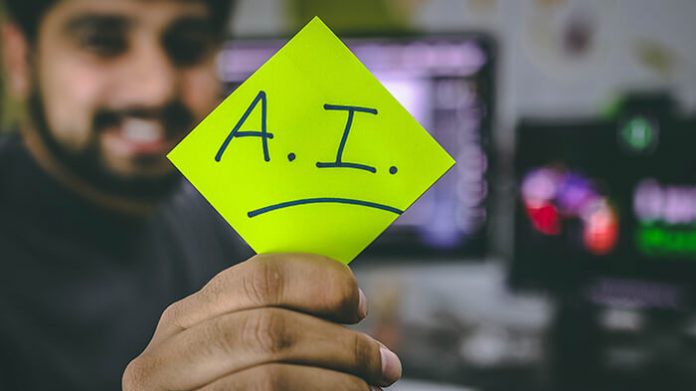By utilizing the manipulation of big data sets and information science, more and more business issues are being solved by artificial intelligence. In-home computer aids like Amazon’s Alexa have become de facto personal assistants. Intelligent automation is becoming a necessity for enterprises of any size. At the same time, manufacturing and transportation are increasingly being handled by learning machines. Online, AI can help customers follow the directions on a website, or a busy working mother figure out what to wear on a day.
If AI can be trusted to follow aesthetic choices that contribute to personal fashion, it begs the question: Can also be used to create art?
Artists might have considered themselves outside the realm of influence by the growth of AI in the professional sphere. After all, machines cannot learn to have the emotional resonance that it requires to create true art. However, the question might be: Can they fake it well enough to fool audiences? Might artificially created art become its own subgenre? Or an even more intriguing question: Is AI going to become an indispensable tool for artists in the future?
AI in Music
With its roots in mathematically controlled harmonies and patterns, music might seem like a natural starting place for machines to emulate an artform. Indeed, an open source music creation platform called Amper allows users to enter information like BPM, genre, and instrumentation to create an original piece designed by AI. Pop songwriter Taryn Southern recently used Amper to help develop her debut album I AM AI. Southern visualises the collaboration with Amper as similar to one that a songwriter might have with a group of musicians. However, the AI allows her total artistic control (something that is more difficult to achieve with a room full of musical collaborators). With an ego-free artificially intelligent co-writer, she is able to begin with a foundation of music from which she crafts iterations and her one signature style.
AI in Painting
In New Jersey, the Art and Artificial Intelligence Lab (AAIL) at Rutgers is making strides toward crossing the uncanny valley between human and machine created paintings. Professor Ahmed Elgammal is leading the charge in this effort and has already conducted double blind studies with critics to see if trained eyes could identify art that was “artificial” vs those painted by human hands. The study concluded incontrovertibly that discerning between the two was impossible. In fact, many imbued the AI created paintings as more resonant and aesthetically pleasing.
This doesn’t mean that collectors will suddenly be able to purchase AI art at low prices. The first piece of AI created art went up for auction in October of 2018 at Christies and astonished critics by selling for over $430,000. “Robot Artist” Jeremy Krabil takes credit (and the cash) for programming the platform that created “Portrait of Edmond de Belamy” which sold for such a surprising sum. The painting, that resembles a man in a dark frock coat was crafted by AI using what is called generative adversarial networks (GAN). As to the question, “Is this art?”, says Krabill, “I think the term ‘art’ is almost too overloaded a term to use in such a question.” It is up to the reader to decide if this a philosophical point or a dodge of the question?
How Does AI Create Art?
Most often, programmers have found success using GANs in the formulation of AI crafted artwork. These networks are made up of two rival intelligences that work in tandem (or perhaps more clearly, in opposition) to make artistic decisions. The two machine intelligences are known as the generator and the discriminator.
In the simplest terms, the GAN is fed a data set and then the generator begins to create random imagery while the discriminator tries to match these images to examples in the data set. These go back and forth between the generator and discriminator until the AI decides what feels most legitimate, given its parameters. While this is an oversimplification of human cognition, it is difficult do divest the process of GANs from the natural way the analytical and creative parts of the human brain work together.
AI Authorship
While passing the Turing test in painting and music, AI has been less successful thus far in narrative arts like fiction and dramatic writing. But that success or failure is only predicated on if the idea is to create something that emulates human creations.
AI researcher Ross Goodwin has embarked on several projects with intriguing results regarding how machines could potentially craft stories. In one endeavor, Goodwin took a machine on the road, attempting to get the AI to create the classic American genre fiction: The road tale. He gave the machine intelligence directives to use surrounding sounds, images, and locative information to create a travel story that would be machine authored. The result 1 The Road does not have discernable plot, character, or story, but the directives feel to Goodwin to be placing the machine on the right track toward more successful authorship. The text feels a kinship to the cut up method novels of William S. Burroughs and Brion Gysin. These surrealist authors believed this method of narrative pastiche to be part of the true nature of the art of storytelling.
Goodwin also has famously attempted screenwriting, working with director Oscar Sharp and Ars Technica to create an AI written screenplay. Using a data set consisting of sci-fi movies from past decades, the machine intelligence, which named itself Benjamin, wrote “Sunspring”, which was subsequently filmed as part of a 48 hours scifi film contest. The movie, starring HBOs Silicon Valley star Thomas Middleditch, has been both ridiculed and lauded as a breakthrough.
While the script does not conform to any human conception of plot or story, there are some remarkable moments of pathos executed by the actors. In a follow-up project, Benjamin was given more responsibility as author, director and star. Sharp and Goodwin accomplish this by feeding the AI stock footage as well as emotional facial expressions to choose from. The result, entitled “Zone Out” is decidedly disconcerting for a human audience, but feels like a step into a different universe.
Goodwin is confident that these baby steps are leading to narrative AI possibilities that will change the future of narrative artwork.
What’s Next?
Already AI is learning to deliver examples of every kind of artistic expression including choreography, culinary expertise and live drama. This infographic from Invaluable.com is an excellent overview of how AI is infiltrating art and what it will mean for artists to work with AI more closely in the future.
Find a Home-Based Business to Start-Up >>> Hundreds of Business Listings.


















































